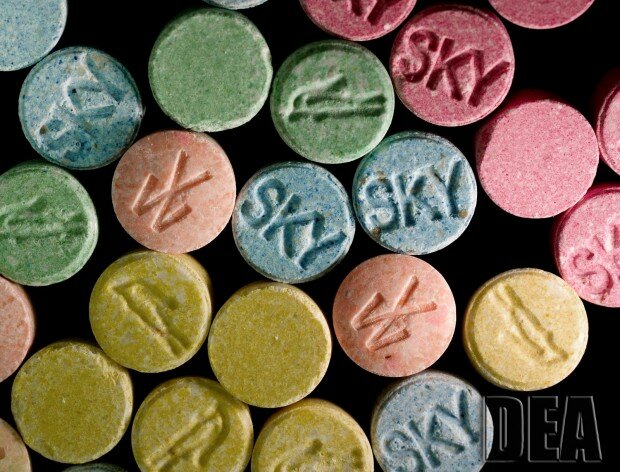With a big EDM show like Dada Life hitting Gainesville this Wednesday, we all know the topic of drugs is at the forefront of everyone’s minds.
Gainesville’s EDM community has slowly been expanding and the use of recreational drugs seems ubiquitous.
The rave scene migrated from underground warehouses and European clubs to evolve into the booming EDM industry it is today. Last year, Electric Zoo became the first major EDM festival to shut its doors due to drug-related deaths. Unfortunately, these kinds of tragic incidents are not rare in the EDM world.
At the time of the incident, writer Shane Morris penned an unsettling essay from the point of view of a drug user and seller called “Finding Molly.” Even this guy, a hardened drug user, finds Molly and the like to be more than a little shady. In a music culture where Molly and other uppers are normalized it’s time to start getting informed.

Via: mixmag.net
What are the facts? What exactly is going on in your brain when you use Molly, cocaine, and really any sort of amphetamine? This is a basic run down of the physiological effects of the drugs you crazy kids will be getting into this week. Or if you just really like science a la Bill Nye the Science Guy-style, this will pique your interest, too.
Brief high school biology review:
There are two main neurotransmitters that are responsible for the good vibes you experience when rolling or snorting or ingesting any upper. The first neurotransmitter we’ll discuss is serotonin, which is affected most by Molly and other forms of MDMA. Serotonin controls mood, appetite, body temperature, heart rate, sleep, memory, sexual desire and social behavior. It affects pretty much everything, so it’s a big fucking deal.
The other neurotransmitter, primarily affected by amphetamines and cocaine, is dopamine. Dopamine is important in the brain’s reward and pleasure centers. Remember when you ate that Relish around 1 a.m. and it was orgasmic good? Yeah, that was dopamine doing its thing. Dopamine also helps motivate our brain to seek that high again. It can push us toward addiction.

Most people incorrectly believe that Molly, cocaine and amphetamines produce more of the neurotransmitter in our bodies. These psychostimulant drugs actually act on the proteins that recycle the neurotransmitters once they are released into our neuron’s synaptic cleft. Think of these proteins as lame baretenders who cut you off when you’ve had one too many. Normally, these little proteins/chaperones reprocess fun neurotransmitters, like dopamine and serotonin, keeping your brain at equilibrium. When you consume any one of these drugs your body’s ability to process and recycle neurotransmitters, such as dopamine and serotonin, decreases significantly. Suddenly, our brains are flooded with excess dopamine or serotonin because our mean, recycling-obsessed chaperones — the proteins — are rendered damaged or inactive. Thus, we’re left with an amazing high.
In the case of cocaine, the recycling protein dopamine transporter is completely blocked by the cocaine, but this only lasts for a short period of time, hence the shorter high.
With amphetamines and methamphetamines (similar to Adderall and Ritalin), the mechanism is slightly different. These drugs also act upon the dopamine transporter protein but in a more drastic way. In a short period of time, when cells are flooded with meth or amphetamines, the dopamine transporter radically changes its shape. Now it’s rendered incapable of recycling dopamine, and it also starts pumping out more — double the fun. After a long period of time, however, the dopamine transporter protein is simply pushed deeper into the cell, away from the membrane, making it unreachable to dopamine attempting to be recycled.

Via: WordPress
Now, on to everyone’s favorite dance drug: Molly, which acts very similarly to its cousin’s amphetamine, meth and cocaine. Except this time it’s acting on the serotonin pathways.
It prevents serotonin transporter from recycling serotonin, thus leading to an overload of this neurotransmitter. So what exactly does this excess serotonin lead to? Well, glad you asked.
Serotonin has receptors in the prefrontal cortex, the amygdala, the hippocampus and motor neurons in the spinal cord. In English: All these parts of the brain control, appetite, memory, emotional reactions, inhibitions, blood vessel widening, blood pressure, sexual desire and muscle contractions.
So all those ravers out there who complain about sweating profusely, not being able to pee, increased heart rate, the sex drive of a high schooler, dilated pupils and TMJ-like jaw clenching — now you know why all those things happen.
Many of the serotonin and dopamine pathways overlap and cause similar results behaviorally, as well as psychologically. Dopamine pathways that begin in the VTA (ventral tegmental area) control cognition, motivation, memory and lack of impulse control. Say hello to your typical coked-out kid.

All of this seems great, right? Elevated mood, euphoria, pleasure, stimulation, increased cognition — these things couldn’t possibly be bad. However, scientists are proving that abusing these pathways has long-term neurological consequences.
Many drug abusers have similar brain damage to those with Alzheimer’s and Parkinson’s. In fact, many researchers are beginning to see that drug abuse can lead to drug-induced (early-onset) Parkinson’s. Some may think, “But I don’t do it that often… I’m just a college kid who’s a recreational drug user.”
That’s all well and good, but the fact is that long-term effects of even one-time use of Molly, meth or amphetamines can lead to permament memory loss or overall decreased production of dopamine or serotonin.
As Shane Morris purports, the drug craze isn’t going away any time soon just because scientific studies have shown that there are scary side effects. But now that you know exactly what’s going on in your brain, maybe you’ll be safer.
Space out your drug use. Don’t over-do it. Drink plenty of water. Stay cool. And don’t think popping a 4 gram capsule will lead to a crazy high and make you a badass. It might just lead to health problems.
Party responsibly.
Featured photo courtesy of: Blogspot





